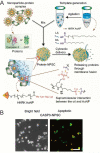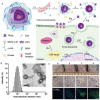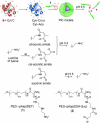Advances in Anticancer Protein Delivery Using Micro-/ Nanoparticles
- PMID: 27642232
- PMCID: PMC5026193
- DOI: 10.1002/ppsc.201400140
Advances in Anticancer Protein Delivery Using Micro-/ Nanoparticles
Abstract
Proteins exhibiting anticancer activities, especially those capable of discriminately killing cancer cells, have attracted increasing interest in developing protein-based anticancer therapeutics. This progress report surveys recent advances in delivering anticancer proteins directly to tumor tissue for inducing apoptosis/necrosis or indirectly to antigen presenting cells for provoking immune responses. Protein delivery carriers such as inorganic particles, lipid particles, polymeric particles, DNA/protein based biomacromolecular particles as well as cell based carriers are reviewed with comments on their advantages and limitations. Future challenges and opportunities are also discussed.
Figures









Similar articles
-
Advanced targeted therapies in cancer: Drug nanocarriers, the future of chemotherapy.Eur J Pharm Biopharm. 2015 Jun;93:52-79. doi: 10.1016/j.ejpb.2015.03.018. Epub 2015 Mar 23. Eur J Pharm Biopharm. 2015. PMID: 25813885 Review.
-
Recent advances of PLGA micro/nanoparticles for the delivery of biomacromolecular therapeutics.Mater Sci Eng C Mater Biol Appl. 2018 Nov 1;92:1041-1060. doi: 10.1016/j.msec.2017.12.036. Epub 2018 Jan 5. Mater Sci Eng C Mater Biol Appl. 2018. PMID: 30184728 Review.
-
Engineered therapeutic proteins for sustained-release drug delivery systems.Acta Biomater. 2023 Nov;171:131-154. doi: 10.1016/j.actbio.2023.09.018. Epub 2023 Sep 16. Acta Biomater. 2023. PMID: 37717712 Review.
-
Tailoring nanocarriers for intracellular protein delivery.Chem Soc Rev. 2011 Jul;40(7):3638-55. doi: 10.1039/c0cs00227e. Epub 2011 May 12. Chem Soc Rev. 2011. PMID: 21566806 Review.
-
Advances in living cell-based anticancer therapeutics.Biomater Sci. 2020 May 6;8(9):2344-2365. doi: 10.1039/d0bm00036a. Biomater Sci. 2020. PMID: 32254876 Review.
Cited by
-
Targeted Myoglobin Delivery as a Strategy for Enhancing the Sensitivity of Hypoxic Cancer Cells to Radiation.iScience. 2020 Jun 26;23(6):101158. doi: 10.1016/j.isci.2020.101158. Epub 2020 May 19. iScience. 2020. PMID: 32464594 Free PMC article.
-
Cytosolic delivery of large proteins using nanoparticle-stabilized nanocapsules.Nanoscale. 2016 Oct 27;8(42):18038-18041. doi: 10.1039/c6nr07162g. Nanoscale. 2016. PMID: 27738697 Free PMC article.
-
Transformable DNA nanocarriers for plasma membrane targeted delivery of cytokine.Biomaterials. 2016 Jul;96:1-10. doi: 10.1016/j.biomaterials.2016.04.011. Epub 2016 Apr 22. Biomaterials. 2016. PMID: 27131597 Free PMC article.
-
Mitochondrial adaptation in cancer drug resistance: prevalence, mechanisms, and management.J Hematol Oncol. 2022 Jul 18;15(1):97. doi: 10.1186/s13045-022-01313-4. J Hematol Oncol. 2022. PMID: 35851420 Free PMC article. Review.
-
Recent advances of cocktail chemotherapy by combination drug delivery systems.Adv Drug Deliv Rev. 2016 Mar 1;98:19-34. doi: 10.1016/j.addr.2015.10.022. Epub 2015 Nov 6. Adv Drug Deliv Rev. 2016. PMID: 26546751 Free PMC article. Review.
References
Grants and funding
LinkOut - more resources
Full Text Sources
Other Literature Sources
